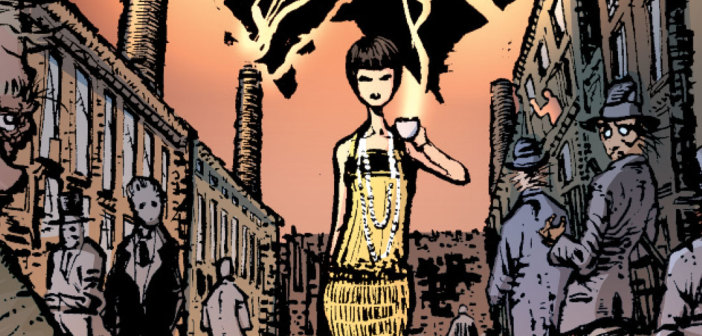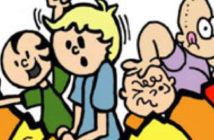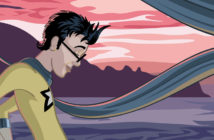The premiere issue of We Will Bury You opens with the tantalizing image of a gritty cityscape that made me a promise the minute I laid my eyes upon it: this is going to be a special comic. The book’s period setting of New York City in the 1920s left me feeling ecstatic. Our heroine, a sassy flapper named Mirah, is a breath of fresh air. The initial caption boxes we read are filled with thoughtful commentary concerning misogyny and women’s rights. The artwork and coloring is skillfully evocative of the time period. There’s even a stray newspaper that headlines the executions of Sacco and Vanzetti, two Italian immigrants believed to be wrongly accused of murder. I was certain this was going to be a smart, witty, and worthwhile read.
And then the zombies show up, and the book crashes and burns before it even gives itself a fighting chance at survival. The writers of We Will Bury You, Brea (of Heroes fame) and Zane Grant, are guilty of pointing their prospective readership in the wrong direction, steering us onto a sad road of missed opportunities and tired clichés.
The late Gene Siskel, world-famous film critic and pop culture icon, refused to watch movie previews; they tainted his experience of the actual films they tried to represent. His surviving partner, Roger Ebert, remembers seeing Siskel covering his ears and staring at the ground, waiting for the coming attractions to finish. That’s my very same method concerning comic book previews and press releases: I don’t even glance at them, let alone read them. So my experience of this book was a wholly untainted one: I opened its pages without a single clue about the plot or the characters.
This is where the deception of the writers lies. The first issue of We Will Bury You is rather wonderful as the story begins. The sexy flapper Mirah is arguing with her husband at the kitchen table about the morals and virtues of womanhood just before she heads out the door to her job as an exotic dancer. At the time, it might have been uncouth for a woman like Mirah to take such a strong charge of her life, but then there wouldn’t have been any magic in the flapper movement, now would there?
Equally interesting is a woman named Fanya, a Ukrainian cross-dresser who wanders around the story doing, well, I’m not really sure what she’s doing or what her purpose is. But she’s got pluck, and seems to have some kind of an intimate relationship with Mirah. When they meet with one another at the flapper’s steamy place of employ, I was thrilled by what the Grants were doing; I was nothing short of convinced that they were going to challenge the status quo of American history by introducing a 1920s version of Thelma and Louise.
And then the zombies pop their rotting heads up, and the book degenerates into a boilerplate exercise of wanton violence and boring action sequences. And when I say they pop up, I mean they literally appear out of no where. The walking dead as a plot device are dropped into the story with the grace of a cinderblock. To say I’m crestfallen that a comic with such promise of being so unique and simply so good crumbled into nothing more than a vapid tale that has already been told countless times—well, that’s putting it lightly.
I don’t get zombies, I really don’t. I cannot fathom their appeal, nor will I ever understand why the love for them is so strong and so widespread in fandom. I recently reviewed another zombie comic, Alan Grant and Simon Bisley’s Dead Kingdom of Flies, and while it was no masterpiece, it accomplished what it wanted to. My Broken Frontier colleague, Bart Croonenborghs, however, felt that I was greatly off the mark in evaluating a book that he opined was terribly subpar.
To each his own, but a book like Dead Kingdom at least knew what it wanted to be. I could clearly see the zombies as a walking metaphor for impending death, the one equalizer that none of us can escape. But in We Will Bury You, the zombies are nothing more than moldering clutter standing in the way of what could have been an excellent piece of historical fiction.
Artist Kyle Strahm delivers unique imagery that is evocative of the time period the comic is set in. His character renderings are especially enjoyable. The heroines in this book are beautiful, while the men who surround them are monstrous to look at. Mirah in particular has the look of Catherine Zeta-Jones in the film Chicago, but her spirit reminds me of Angelina Jolie’s gripping performance in Changeling. The art is handsomely coupled with the colors of Zac Atkinson who shades the book with rich hues that set the ambience when it’s most needed.
But artwork isn’t enough to help a book swim on its own. A comic’s writing will ultimately decide its sink-or-swim fate, and unfortunately Brea and Zane Grant have delivered a major miss that could have been one hell of a hit. As I read the book, I wondered if the zombies were a metaphor not for death, but the oppression of women at the hands of men. It’s possible, but does it really matter? The zombies by their very nature drain away any interest or delight from this book the moment they appear, and it’s a great shame.
This comic book review originally appeared on Broken Frontier on 25 February 2010.




